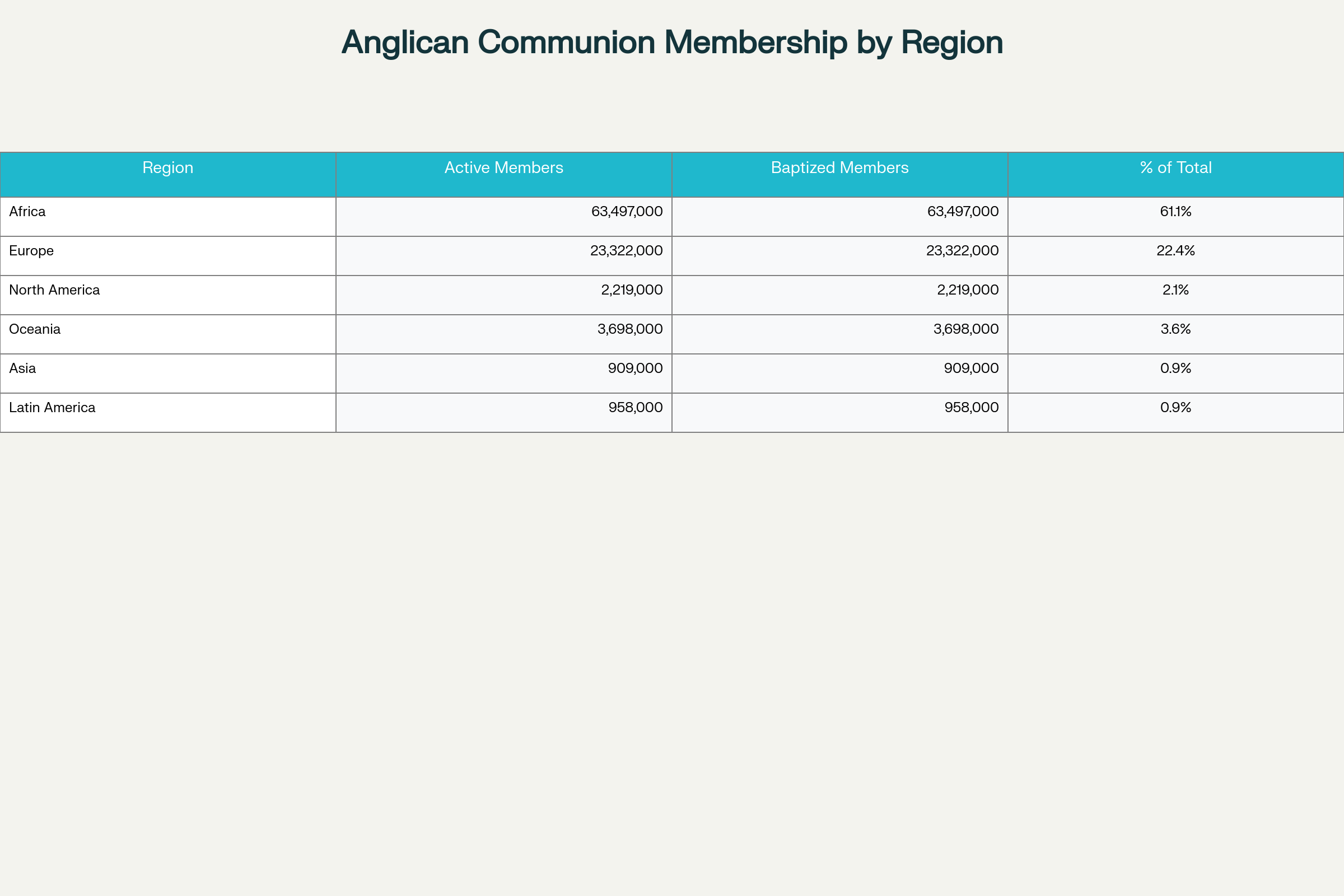Key Highlights:
- Dame Sarah Mullally becomes the first woman to lead the Church of England since its establishment in 597 AD
- The 63-year-old former chief nursing officer will officially take charge in March 2026 following formal ceremonies
- Her appointment oversees the global Anglican Communion of approximately 100 million members across 42 autonomous provinces
Britain has shattered centuries of ecclesiastical tradition with the appointment of Dame Sarah Mullally as the Archbishop of Canterbury, marking the first time in the Church of England’s 1,400-year history that a woman will lead the institution. The announcement, made on Friday by Prime Minister Keir Starmer’s office with formal consent from King Charles III, represents a seismic shift for the Anglican Communion and its approximately 100 million members worldwide.
Dame Sarah Mullally makes history as the first female Archbishop of Canterbury and the Sky news headline fails to name her but it’s ok, her husband is named instead 🙄.
— Jo Stevens (@JoStevensLabour) October 3, 2025
Congratulations Sarah #trailblazer pic.twitter.com/1MkV9JTXLP
This historic decision follows nearly a year-long selection process that concluded with the Crown Nominations Commission choosing Mullally to succeed Justin Welby, who resigned in November 2024 following a child abuse cover-up scandal. The appointment of the Archbishop of Canterbury signals a transformative moment for global Christianity, as the position carries spiritual leadership responsibilities for 85 million Anglicans across 42 autonomous provinces spanning six continents.
Breaking Barriers In Traditional Leadership
- Dame Sarah Mullally’s appointment ends a male-only tradition dating back to Augustine of Canterbury in 597 AD
- The selection process involved extensive consultation with global Anglican representatives and thousands of public submissions
Dame Sarah Mullally’s elevation to Archbishop of Canterbury represents more than a simple leadership change within the Church of England structure. At 63 years old, Mullally brings a unique background as the former Government’s Chief Nursing Officer for England, having specialized as a cancer nurse before her calling to ministry. The Crown Nominations Commission, led by Lord Evans of Weardale and comprising 17 voting members including representatives from the global Anglican Communion, conducted an extensive discernment process that began with public consultation hearing from thousands of participants.
This comprehensive approach to selecting the Archbishop of Canterbury reflected the institution’s commitment to inclusive decision-making, with the commission specifically seeking to avoid a candidate profile that was traditionally “white, Oxbridge, male, and from the southeast of England”. The Archbishop of Canterbury appointment process took nearly a year to complete, significantly longer than other major religious appointments, demonstrating the careful consideration given to this historic decision.
Global Anglican Community Transformation
- The Anglican Communion has grown to approximately 100 million members worldwide, increasing by one million annually
- Africa now represents the largest portion of global Anglicanism, with Nigeria, Uganda, and Kenya constituting nearly half the communion
The Archbishop of Canterbury now leads a dramatically transformed global Anglican community that extends far beyond England’s borders. According to recent scholarship from Durham University’s David Goodhew, the Anglican Communion has doubled in size over the past 50 years, with membership growing by approximately one million people annually. This growth has been driven primarily by expansion in sub-Saharan Africa, where the Church of Nigeria has become the largest Anglican province globally, surpassing even the Church of England in membership numbers.
The Archbishop of Canterbury’s role as ceremonial leader encompasses this diverse global community, with significant concentrations in Africa (63.5 million members), Europe (23.3 million), and smaller but vital communities across Oceania, North America, Asia, and Latin America. The transformation of the Anglican Communion from a primarily European institution to a global movement presents unique challenges for the Archbishop of Canterbury, who must navigate theological differences between conservative churches in African nations and more progressive voices in Western countries.

Global Anglican Communion membership distribution by region showing the concentration of members across different continents
Theological Challenges And Conservative Opposition
- Conservative Anglican groups across Africa and Asia have criticized the appointment, viewing it as contrary to traditional biblical interpretation
- The Global Anglican Future Conference represents the majority of global Anglicans and opposes female episcopal consecration
The appointment of the Archbishop of Canterbury has already generated significant theological controversy within the broader Anglican Communion. The Global Anglican Future Conference (GAFCON), which claims to represent the majority of worldwide Anglicans and had previously rejected Justin Welby’s approach to homosexuality, maintains that only men should be consecrated as bishops. This conservative opposition to the Archbishop of Canterbury appointment reflects deeper divisions within global Anglicanism over women’s ordination, same-sex relationships, and biblical interpretation. The tension particularly manifests in relationships between the Church of England and conservative Anglican provinces in Africa and Asia, where traditional views on gender roles and sexuality predominate.
Previous archbishops of Canterbury have struggled to maintain unity while balancing conservative churches in African nations, where homosexuality remains illegal in many jurisdictions, against more liberal Anglican voices in Western countries. The Archbishop of Canterbury position has become increasingly complex as the global Anglican movement has shifted its demographic center from Europe to the Global South, where theological conservatism often prevails.
Institutional Reform Following Scandal
- Justin Welby’s resignation followed the Makin Review exposing decades-long cover-up of child abuse by barrister John Smyth
- The Church of England has implemented extensive safeguarding reforms and transparency measures since 2024
The Archbishop of Canterbury appointment comes in the context of institutional crisis and necessary reform within the Church of England. Justin Welby’s resignation in November 2024 followed the publication of the Makin Review, which exposed a “long-maintained conspiracy of silence” regarding abuse perpetrated by barrister John Smyth at Christian summer camps across Britain, Zimbabwe, and South Africa. The report revealed that Welby failed to ensure proper investigation into abuse allegations after being informed in 2013, leading to what he described as a “long and re-traumatizing period between 2013 and 2024”.
The Archbishop of Canterbury succession process was deliberately extended to allow for comprehensive vetting and consultation, reflecting lessons learned from the abuse scandal and the need for enhanced transparency. The institutional challenges facing the Archbishop of Canterbury extend beyond individual misconduct to broader questions of safeguarding, accountability, and maintaining public trust in religious leadership. Dame Sarah Mullally’s appointment signals the Church of England’s commitment to reform and modernization, though critics argue that leadership changes alone cannot address systemic institutional problems.
Professional Background And Ecclesiastical Journey
- Mullally served as Government Chief Nursing Officer for England, the youngest person ever appointed to the role at age 37
- Her ecclesiastical career progressed from parish priest in 2002 to Bishop of London in 2018
The Archbishop of Canterbury brings an extraordinary professional background combining healthcare leadership with theological scholarship. Before ordination, Dame Sarah Mullally achieved distinction as the Government’s Chief Nursing Officer for England, appointed at the remarkably young age of 37 after specializing as a cancer nurse. Her educational foundation spans both secular and theological institutions, including South Bank University London, Heythrop College University of London, and the South East Institute of Theological Education.
The Archbishop of Canterbury’s ecclesiastical journey began with ordination as a priest in 2002, followed by parish leadership roles including Team Rector at Christ Church Sutton in Southwark Diocese from 2006. Her progression through Church hierarchy accelerated with appointment as Canon Residentiary and Treasurer at Salisbury Cathedral in 2012, consecration as Suffragan Bishop of Crediton in Devon in 2015, and elevation to Bishop of London in 2018. The Archbishop of Canterbury designation represents the culmination of a career characterized by breaking barriers, as Mullally also became the first woman to serve as Bishop of London, one of the Church of England’s most senior positions.
Closing Assessment
Dame Sarah Mullally’s appointment as Archbishop of Canterbury represents a watershed moment for global Christianity, marking the end of nearly 1,400 years of exclusively male leadership in one of the world’s most influential religious institutions. The selection of the Archbishop of Canterbury reflects the Church of England’s evolution from a predominantly English institution to the ceremonial head of a global Anglican Communion spanning 100 million members across six continents. While conservative Anglican provinces in Africa and Asia have expressed opposition to female episcopal leadership, the appointment demonstrates the Church of England’s commitment to gender equality and institutional modernization.
The Archbishop of Canterbury will face the complex challenge of maintaining unity within an increasingly diverse and theologically divided global communion while implementing reforms necessary to restore public trust following abuse scandals. The historic nature of this appointment extends beyond symbolic representation to practical implications for Anglican theology, global ecumenical relationships, and the future direction of one of Christianity’s major denominations.


